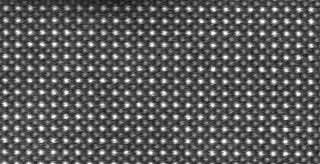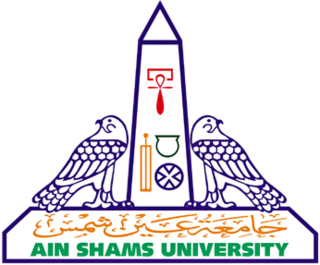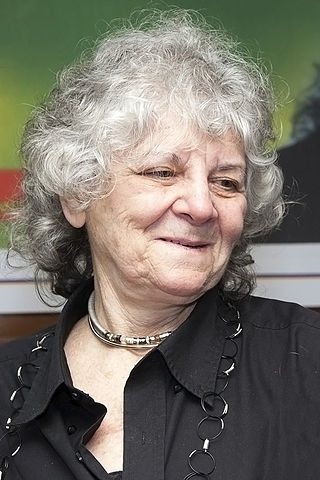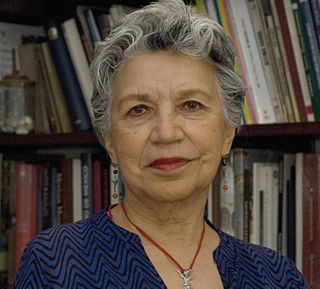Related Research Articles

Crystallography is the experimental science of determining the arrangement of atoms in crystalline solids. Crystallography is a fundamental subject in the fields of materials science and solid-state physics. The word crystallography is derived from the Ancient Greek word κρύσταλλος, with its meaning extending to all solids with some degree of transparency, and γράφειν. In July 2012, the United Nations recognised the importance of the science of crystallography by proclaiming that 2014 would be the International Year of Crystallography.

Dame Kathleen Lonsdale was an Irish pacifist, prison reformer and crystallographer. She proved, in 1929, that the benzene ring is flat by using X-ray diffraction methods to elucidate the structure of hexamethylbenzene. She was the first to use Fourier spectral methods while solving the structure of hexachlorobenzene in 1931. During her career she attained several firsts for female scientists, including being one of the first two women elected a Fellow of the Royal Society (FRS) in 1945, first woman tenured professor at University College London, first woman president of the International Union of Crystallography, and first woman president of the British Association for the Advancement of Science.
Farkhonda Hassan was a professor of Geology at the American University in Cairo and was chair of the Commission on Human Development and Local Administration of the Shura Council.

Ain Shams University is a public university located in Cairo, Egypt. Founded in 1950, the university provides education at the undergraduate, graduate and post-graduate levels.

The L'Oréal-UNESCO For Women in Science Awards, created in 1998, aim to improve the position of women in science by recognizing outstanding women researchers who have contributed to scientific progress. The awards are a result of a partnership between the French cosmetics company L'Oréal and the United Nations Educational, Scientific and Cultural Organization (UNESCO) and carry a grant of $100,000 USD for each laureate. This award is also known as the L'Oréal-Helena Rubinstein Women in Science Awards.

Kedareswar Banerjee was an X-ray crystallographer and director of the Indian Association for the Cultivation of Science, Kolkata. Early in his career he determined the structures of naphthalene and anthracene. In 1931, he worked with Sir William Henry Bragg and developed one of the first direct methods of crystal structure determination. He was Professor of Physics at the Indian Association for the Cultivation of Science from 1943 to 1952 and Director of the Association from 1959 until his retirement in 1965. Between 1952 and 1959 he was Head of the Department of Physics at Allahabad University. His interests in crystallography were widespread and, with his death, India has lost a renowned teacher. K. Banerjee joined the research group of Sir C. V. Raman at the Indian Association for the Cultivation of Science (IACS), Calcutta, a premier Indian research institute of India. He worked in various institutions including IACS, the India Meteorological Department, University of Dhaka and Allahabad University and finally retired as the Director of IACS, Calcutta in 1965. Prof. Banerjee explained some points of crystal research to Homi J. Bhabha also.

Ada E. Yonath is an Israeli chemist and Nobel laureate crystallographer best known for her pioneering work on the structure of ribosomes. She is the current director of the Helen and Milton A. Kimmelman Center for Biomolecular Structure and Assembly of the Weizmann Institute of Science.

Dame Pratibha Laxman Gai-Boyes is a British microscopist and Professor and Chair of Electron Microscopy and former Director at The York JEOL Nanocentre, Departments of Chemistry and Physics, University of York. She created the atomic-resolution environmental transmission electron microscope (ETEM) and is an outspoken advocate for women with careers in science.
Professor Akiko Kobayashi is a Japanese chemist born in Tokyo. She is the designer and creator of Ni(tmdt)2, the world's first single-component molecular metal.

Silvia Torres-Peimbert is a Mexican astronomer. She won the L'Oréal-UNESCO Awards for Women in Science in 2011 for Latin America for her work determining the chemical composition of nebulae.
Li Fanghua was a Hong Kong-born Chinese physicist. She was a member of the Chinese Academy of Sciences, The World Academy of Sciences, and the International Union of Crystallography. She was also the director of Chinese Society of Physics and China Union of Crystallography, and an editor of the Journal of Chinese Electron Microscopy Society, J. Electron Microscopy, Chinese Physics Letter, and Chinese Journal of Physics.
Rajaâ Cherkaoui El Moursli is a Moroccan Professor of nuclear physics, at the faculty of science within the Mohammad V University of Rabat.
Mariana Weissmann is an Argentinian physicist, specializing in the computational physics of condensed matter. In 2003, Weissmann became the first Argentinian scientist to receive the L'Oréal-UNESCO Award to Women in Science. The same year she received the Prize Konex in Physics.
Elizabeth Armstrong Wood (1912–2006) was an American crystallographer and geologist who ran a research program at Bell Telephone Laboratories that led to the development of new superconductors and lasers. She was known for the clarity of her writing and her efforts to educate the general public about scientific subjects.
Mercedes Vila Juárez is a Spanish material science researcher. She is the chief technology officer (CTO) and co-founder of BioTech Foods SL.
Sabrina Stierwalt is an American extragalactic astrophysicist who studies gas dynamics and the formation and evolution of galaxies through surveys utilizing x-ray, ultraviolet, optical, infrared, submillimeter, and radio wavelengths. She is experienced in science communication and advocating for equality and equity for underrepresented groups in science, technology, engineering, and mathematics (STEM) fields.

Karen Astrid Hallberg is an Argentine scientist and professor of physics at the Balseiro Institute. and at the Bariloche Atomic Centre. Se was awarded the 2019 L'Oreal-UNESCO Award for Women in Science Laureate.
Hilda Cid Araneda is a Chilean scientist who excelled in the field of crystallography. She was the first Chilean female to complete a PhD in Exact Sciences. She made remarkable contributions both as a professor of mathematics and physics and as influential researcher on structural biology, specially in protein crystallography.

Adriana Cristina Serquis is an Argentine physicist, the president of the National Atomic Energy Commission (CNEA), and principal researcher of the National Scientific and Technical Research Council (CONICET). In 2014, she received the L'Oréal-UNESCO National Award For Women in Science for her contribution to the rational use of electrical energy.
Maia Garcia Vergniory is a Spanish computational physicist who is a group leader at the Max Planck Institute for Chemical Physics of Solids. Her work in topological quantum chemistry investigates the phases of topological materials. She was elected Fellow of the American Physical Society in 2022.
References
- 1 2 "Karimat El Sayed". Ain Shams University. November 12, 2013. Archived from the original on February 2, 2016. Retrieved March 17, 2014.
- 1 2 3 El-Rashidi, Yasmine (April 10–16, 2003). "Karimat El-Sayed". Al-Ahram Weekly. Archived from the original on May 7, 2013. Retrieved March 17, 2014.
- 1 2 Workman, Shawne (March 17, 2009). "Egyptian Crystallographer to Share Unique Perspectives in Science and Culture". SLAC Today. Retrieved March 17, 2014.
- 1 2 A Woman of Substance, Gulf News, 2003, retrieved March 17, 2014
- ↑ "Egypt". 2014 International Year of Crystallography. Retrieved March 17, 2014.
- ↑ "L'ORÉAL-UNESCO science award". International Union of Crystallography. 2003. Retrieved March 17, 2014.